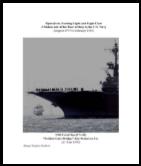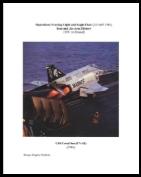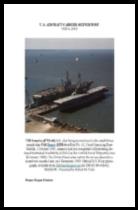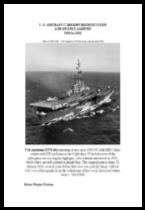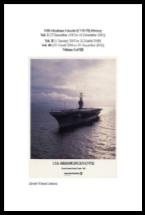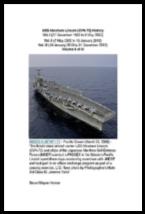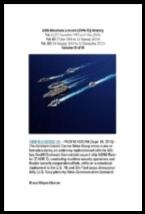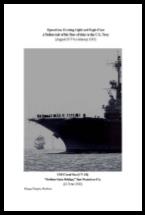






|
CHAPTER XXV Part 2 of 2 (25 January to 8 March 1973) |
|
USS Midway (CVA-41) underway on 20 June 1963, with F-3 Demon, F-4B Phantom II and F-8 Crusader jet fighters on her flight deck. The two Crusaders parked furthest forward are from Fighter Squadron 24 (VF-24). Photographed by PH1 J.D. Osborne. Official U.S. Navy Photograph, from the collections of the Naval Historical Center (# NH 97632). NS024123. NHC. |

|
A Sailors tale of his Tour of duty in the U.S. Navy (August 1977 to February 1983) Operation Evening Light and Eagle Claw - 24 April 1980
Book - ISBN NO. 978-1-4276-0454-5 EBook - ISBN NO. 978-1-329-15473-5
Operations Evening Light and Eagle Claw (24 April 1980) Iran and Air Arm History (1941 to 1980)
Book ISBN NO. xxxxxxxxxxxxx EBook ISBN NO. 978-1-329-19945-3
U. S. AIRCRAFT CARRIER SHIP HISTORY (1920 to 2019)
Book - ISBN NO. 978-1-4276-0465-1 EBook - ISBN NO. 978-1-365-25019-4 Library of Congress Control Number: 2008901616 (Book Version)
U. S. AIRCRAFT CARRIERS REDESIGNATED AND OR RECLASSIFIED (1953 to 2016)
BOOK - ISBN NO. 978-1-4276-0452-1 EBook - ISBN NO. 978-1-365-25041-5 Library of Congress (Book Version) 2008901619
ENERGY QUEST AND U. S. AIRCRAFT CARRIER DEPLOYMENT HISTORY INVESTMENT CAPITAL REQUIRED TO PUBLISH 55 EIGHTH HUNNDRED PAGE BOOKS, EBOOKS & CD’s (48 Navy Books)
Book - ISBN NO. To Be Announced EBook - ISBN No. 978-1-365-26038-4
USS Abraham Lincoln (CVN-72) History Vol. I of III (27 December 1982 to 6 May 2003)
Book Vol. I of IV ISBN: TBA EBook Vol. I of IV ISBN: 978-1-365-73794-7
USS Abraham Lincoln (CVN-72) History Vol. II of III (7 May 2003 to 13 January 2010)
Book - ISBN NO. To Be Announced EBook - ISBN NO. 978-1-365-74027-5
USS Abraham Lincoln (CVN-72) History Vol. III of III (14 January 2010 to 31 December 2012)
Book - ISBN NO. To Be Announced EBook - ISBN No. 978-1-365-74145-6
USS Coral Sea CV-42 CVB-43 CVA-43 and CV-43 History and Those Aircraft Carriers Operating with Coral Sea During Her Tour of Service CONSTRUCTION to LAUNCHING and EARLY JET AIRCRAFT DEVELOPMENT (10 July 1944—2 April 1946) and a Tour of Duty in the U. S. Navy (August 1977 to February 1983)
ISBN: 9781434382917
|
|
Ending the War and Restoring Peace in Vietnam
“The Paris Peace Accords, officially titled the Agreement on Ending the War and Restoring Peace in Vietnam, was a peace treaty signed on January 27, 1973 to establish peace in Vietnam and end the Vietnam War. The treaty included the governments of the Democratic Republic of Vietnam (North Vietnam), the Republic of Vietnam (South Vietnam), and the United States, as well as the Provisional Revolutionary Government (PRG) that represented indigenous South Vietnamese revolutionaries” (Ref. Wikipedia® is a registered trademark of the Wikimedia Foundation, Inc., a non-profit organization).
“It ended direct U.S. military combat, and temporarily stopped the fighting between North and South Vietnam. However, the agreement was not ratified by the United States Senate” (Ref. [1] & [2] - Wikipedia® is a registered trademark of the Wikimedia Foundation, Inc., a non-profit organization). https://en.wikipedia.org/wiki/Paris_Peace_Accords
1. The Paris Agreement on Vietnam: Twenty-five Years Later Conference Transcript, The Nixon Center, Washington, DC, April 1998. Reproduced on mtholyoke.edu. Accessed 5 September 2012 & 21 April 2017. https://www.mtholyoke.edu/acad/intrel/paris.htm 2. The Constitution - Executive agreements Accessed 21 April 2017. http://www.americanforeignrelations.com/A-D/The-Constitution-Executive-agreements.html
“The negotiations that led to the accord began in 1968, after various lengthy delays. As a result of the accord, the International Control Commission (ICC) was replaced by the International Commission of Control and Supervision (ICCS) to fulfill the agreement.
The main negotiators of the agreement were United States National Security Advisor Henry Kissinger and Vietnamese politburo member Lę Đức Thọ; the two men were awarded the 1973 Nobel Peace Prize for their efforts, although Lę Đức Thọ refused to accept it.
The document began with the statement that "the United States and all other countries respect the independence, sovereignty, unity, and territorial integrity of Vietnam as recognized by the 1954 Geneva Agreements on Vietnam". The inclusion of this provision was a victory for the communist side of the negotiations by allowing that the war was not a foreign aggression against South Vietnam. The main military and political provisions of the agreement were:
Beginning on 27 January 1973 at midnight, Greenwich Mean Time—in Saigon time, 08:00 on 28 January—there would be an in-place ceasefire.
1. North and South Vietnamese forces were to hold their locations.
2. They were permitted to resupply military materials to the extent necessary to replace items consumed in the course of the truce.
3. Once the ceasefire is in effect, U.S. troops (along with other non-Vietnamese soldiers) would begin to withdraw, with withdrawal to be complete within 60 days.
4. Simultaneously, U.S. prisoners of war would be released and allowed to return home.
5. The parties to the agreement agreed to assist in repatriating the remains of the dead.
6. There would be negotiations between the two South Vietnamese parties—Saigon and the Vietcong—towards a political settlement that would allow the South Vietnamese people to "decide themselves the political future of South Viet-Nam through genuinely free and democratic general elections under international supervision."
7. Reunification of Vietnam was to be "carried out step by step through peaceful means"” (Ref. Wikipedia® is a registered trademark of the Wikimedia Foundation, Inc., a non-profit organization). https://en.wikipedia.org/wiki/Paris_Peace_Accords
“Operation Homecoming, the repatriation of U.S. POWs commenced 27 January 1973 and North Vietnam and the Viet Cong began releasing” (Ref. 1-Ranger & 72).
“The Vietnam cease-fire, announced on 23 January 1972 went into effect on the 27th. Aircraft from USS Constellation (CVA-64) and USS Oriskany (CVA-34) operating on "Yankee Station," the location of which was changed to a position off the coast of the northern part of South Vietnam, flew strikes against targets in southern Laos. Combat sorties from carriers on "Yankee Station" against targets in Laos had continued since the cease-fire in Vietnam. These combat support sorties were flown in support of the Laotian government which had requested this assistance and it had no relationship with the cease-fire” (Ref. 1-Constellation & 72).
“USS Midway (CVA-41) made a port of call at Subic Bay, Republic of Philippines from 25 January to 2 February 1973, departing to conduct combat missions on her ninth line period in the South China Sea and the Gulf of Tonkin when CVW-5 began flight operations on “Yankee Station” against Laos targets” (Ref. 405 & USS MIDWAY Command History for Calendar Year 1973).
“ADR3 WILLIAM S. STRINGHAM, VAW-115 was lost at sea, en route “Yankee Station,” on 3 February 1973, USS Midway (CVA-41) commenced combat missions on her ninth line period in the South China Sea and the Gulf of Tonkin when CVW-5 began flight operations on “Yankee Station” against Laos targets on 4 February 1973. Since the peace agreement applying to Vietnam had been signed, the only targets authorized for strikes were in Laos.
USS Midway (CVA-41) conducted strikes in Laos, since the peace agreement applying to Vietnam had been signed, the only targets authorized for strikes were in Laos, on her ninth line period and final time during the cruise (4 to 9 February 1973) on “Yankee Station” in the South China Sea and the Gulf of Tonkin when CVW-5 began flight operations on “Yankee Station” against Laos targets from and 4 to 9 February 1973.
USS Midway (CVA-41) Ninth Line Period in the South China Sea and the Gulf of Tonkin when CVW-5 began flight operations on “Yankee Station” against Laos targets from 4 to 9 February 1973” (Ref. USS MIDWAY Command History for Calendar Year 1973):
1973 Laos Sortie statistics:
1973 BDA – (bomb damage assessment) in Laos:
“USS Midway (CVA-41) arrived Subic Bay, Republic of Philippines, mooring at Leyte Pier, NAS Cubi Point on 10 February 1973, ending her ninth line period and final time during the cruise (4 to 9 February 1973) on “Yankee Station” in the South China Sea and the Gulf of Tonkin when CVW-5 began flight operations on “Yankee Station” against Laos targets from 4 to 9 February 1973 (6-days).
USS Midway (CVA-41) made a port of call at Subic Bay, Republic of Philippines, mooring at Leyte Pier, NAS Cubi Point from 10 to 15 February 1973, departing for Pearl Harbor, Hawaii, ern route Naval Air Station, Alameda, California.
USS Midway (CVA-41) anchored at Pearl Harbor, Hawaii on 26 February 1973, to off-load ammo and take on fuel. Commander Western Sea Frontier visited the ship prior to its departure later on 26 February 1973 for Naval Air Station, Alameda, California” (Ref. 405 & USS MIDWAY Command History for Calendar Year 1973).
“On 8 March 1973, USS Midway (CVA-41) with Rear Admiral W. R. Flanagan, relieving Rear Admiral J. L. Butts, Commander and Captain K. L. Shugart, as Chief of Staff, Carrier Division One and Captain C. E. Myers, Commander, Carrier Air Wing 5 (CVW-5) embarked arrived Naval Air Station, Alameda, California, with Captain S, R. Foley, Jr. USNA '50, relieved Captain W. L. Harris, Jr., USNA ’37, as Commanding Officer, ending her ninth “WestPac” deployment, operating with the Pacific Fleet and the 7th Fleet, on her 8th South China Sea, on her third Vietnam Combat Cruise on “Yankee Station,” in the Gulf of Tonkin in the Far East, conducting Operational Readiness Exercise (ORE); conducting combat sorties against communist forces in North Vietnam, South Vietnam and Cambodia, returning to the war zone seven weeks earlier than her scheduled deployment date, on “Yankee Station” responsibility again on 30 June 1971, on “Yankee Station,” conducting Combat Missions, Special Operations, Single Carrier Operations and Air Operatins on nine line periods sin the South China Sea in the Gulf of Tonkin, during which time, the ship and air wing participated in Operation Pocket Money, the mining campaign against principal North Vietnamese ports, developed to cut that flow of supplies and Operation Linebacker I, an outgrowth of Operation Freedom Train and President Richard M. Nixon's mining declaration, which also stated that the U.S. would make a maximum effort to interdict the flow of supplies in North Vietnam. On this first day of Linebacker I, the Navy shifted its attacks from targets in southern North Vietnam to the coastal region embracing Haiphong north to the Chinese border. In all, 173 attack sorties were flown in this region this day, although another 62 were directed into South Vietnam in continuing support of allied forces there. Meritorious Unit Commendation was awarded Midway on 15 April 1972. Ports of calls include: Subic Bay, Republic of Philippines; Subic Bay, Republic of Philippines a second time; Subic Bay, Republic of Philippines a third time; Subic Bay, Republic of Philippines a fourth time; Hongkong, B. C. C., situated on China's south coast and, enclosed by the Pearl River Delta and South China Sea; Subic Bay, Republic of Philippines a fifth time; Subic Bay, Republic of Philippines a sixth time; Subic Bay, Republic of Philippines a seventh time; Singapore, is a Southeast Asian island city-state off the southern tip of the Malay Peninsula, 137 kilometres (85 mi) north of the equator (An island country made up of 63 islands, it is separated from Malaysia by the Straits of Johor to its north and from Indonesia's Riau Islands by the Singapore Strait to its south); Subic Bay, Republic of Philippines a eight time; Subic Bay, Republic of Philippines, mooring at Leyte Pier, NAS Cubi Point a ninth time and Subic Bay, Republic of Philippines, mooring at Leyte Pier, NAS Cubi Point a tenth time. Squadrons: VF-161, F-4B; VF-151, F-4B; VA-93, A-7B; VA-56, A-7B; VA-115, A-6A / KA-6D, VFP-63 Det. 3, RF-8G; VAW-115, E-2B; VAQ-130 Det. 2, EKA-3B; HC-1 Det. 8, SH-3G and HC-7 Det. 110, HH-3A. *These squadron detachments were not aboard the carrier for the entire deployment. USS Worden (CG-18) and USS Towers (DDG-9) joined up with Midway as part of her task force. Her second deployment since her second recommission 31 January 1970, following completion of a four-year conversion-modernization at the San Francisco Bay Naval Shipyard, arriving 11 February 1966, ending the year of 1965 upon arrival from her seventh “WestPac” deployment, operating with the Pacific Fleet, conducting Operational Readiness Inspection (ORI) and Nuclear Operational Readiness Maneuver (NORM) and the 7th Fleet, on her seventh South China Sea, on her first Vietnam Combat Cruise on “Yankee Station” in the Gulf of Tonkin in the Far. Her second deployment since her second recommission 31 January 1970, following completion of a four-year conversion-modernization at the San Francisco Bay Naval Shipyard, arriving 11 February 1966, ending the year of 1965 upon arrival from her seventh “WestPac” deployment, operating with the Pacific Fleet and the 7th Fleet, her seventh South China Sea, on her first Vietnam Combat Cruise on “Yankee Station” in the Gulf of Tonkin in the Far East. Her eighth deployment since her first recommission upon completion of SCB-110 (August 1955 to 30 September 1957), decommissioning in August 1955 upon arrival from her World Cruise and first “WestPac” deployment, operating with the U.S. Atlantic Command (USLANTCOM) (Atlantic Fleet), operational control extending to the 2nd Fleet and Pacific Fleet and tour of duty with the 7th Fleet, on her first South China Sea deployment, for a five month SCB-110 modernization that included new innovations such as an enclosed bow and an angled flight deck to be installed at Puget Sound Naval Shipyard, Bremerton Washington. In April 1971, Midway made her seventeenth deployment, not sixteenth (second Caribbean Sea Cruise in areas off Guantanamo Bay, Cuba, and Culebra Island, Puerto Rico. While en route on 22 April 1946, Midway rendered a 21-gun salute to President Harry S, Truman who joined the task group in USS Frankland D. Roosevelt (CVB-42), flagship of the EIGHTH Fleet (and after visiting Port of Spain, Trinidad, the President left the task Group (1st FWFD) (19 April to 10 June 1946 (53-days)) or 3rd North Atlantic Cruise (Ports of calls included: Firth of Clyde, Greenock, Scotland Cherbourg, France) (26 August to 8 October 1952 (37-days)), as reported in Midway’s 1971 Command History Report 13,000 tons heavier than her original full pay load figure; redesignated CVA-41 on 1 October 1952. Her 18th Foreign Water Fleet Deployment (FWFD) since her commission 10 September 1945, having the destination of being the lead ship of her class, and the first to be commissioned after the end of lead ship of her class, and the first to be commissioned after the end of World War II” (Ref. 1-Midway, 72, 1181, 1181A, 1181B, 1181C, 1181DD, 1181E, 1181E1, 1181F, 1181G, 1181H, 1181I, 1181J, 1181N, USS MIDWAY Command History for Calendar Year 1946, 1952, 1971 & 1972).
USS Midway (CVA-41) Ninth “WestPac” deployment (1972/73) Senior Command and Staff – USS Midway (CVA 41) WestPac Cruise Book 1972-73 – Chapter 26, Appendix I.
USS Midway (CVA-41) 3rd Vietnam Combat Cruise 1972 and 1973 North Vietnam Sortie statistics and BDA – (bomb damage assessment) for First to Seven Line Periods during (30 April to 20 December 1972); Eighth during North Vietnam and Laos Operations (4 to 23 January 1973) and her Ninth Line Period during Laos Operations (4 to 9 February 1973). (10 April 1972 to 8 March 1973) –Chapter 26, Appendix II.
USS Midway (CVA-41) 3rd VIETNAM COMBAT CRUISE BDA (bomb damage assessment - Destroyed / Fires and Damaged) for First through Ninth Line Periods similar targets during 1972 and 1973 North Vietnam, South Vietnam and Cambodia Operations - 9th WestPac” Deployment (10 April 1972 to 8 March 1973) – Chapter 26, Appendix III.
USS Midway (CVA-41) 3rd VIETNAM COMBAT CRUISE, AWARDS AND CASUALTY REPORTS - 9th WestPac” Deployment (10 April 1972 to 8 March 1973) – Chapter 26, Appendix IV.
USS Midway (CVA-41) 3rd VIETNAM COMBAT CRUISES, AWARDS AND CASUALTY REPORTS (7th, 8th and 9th WestPac” Deployments) (6 March 1965 to to 8 March 1973) – Chapter 26, Appendix V.
USS Midway (CVA-41) 1972 YEARS END SUMMARY – Chapter 26, Appendix VI.
a. Engineering: b. AIMD: c. Medical: d. Communications: e. Dental: f. Deck: g. Weapons expenditures: h. Air Department:
USS Midway (CVA-41) Ninth “WestPac” deployment, operating with the Pacific Fleet and the 7th Fleet, on her ninth South China Sea, on her third Vietnam Combat Cruise on “Yankee Station” in the Gulf of Tonkin in the Far East Summary (10 April 1972 to 8 March 1973) – Chapter 26, Appendix VII.
1973 YEARS END SUMMARY Schedule, Sequence of Events, Visitors, Awards, Caualities and Special Topics (9 March to 31 December 1973) – Chapter 30, Appendix I.
1. Operations Department 2. Engineering Department 3. Air Department 4. Aircraft Intermediate Maintenance Department (AIMD) 5. Communications Department
6. Weapons Department 7. Deck Department
8. Navigation Department 9. Supply Department 10. Medical Department 11. Dental Department 12. Executive Department
Ninth “WestPac” deployment (1972/73) Senior Command and Staff CHAPTER XXVI Appendix I
USS Midway (CVA 41) WestPac Cruise Book 1972-73 |
||||||||||||||||||||||||||||||||||||||||||||||||||||||||||||||||||||||||||||||||||||||||||||||
